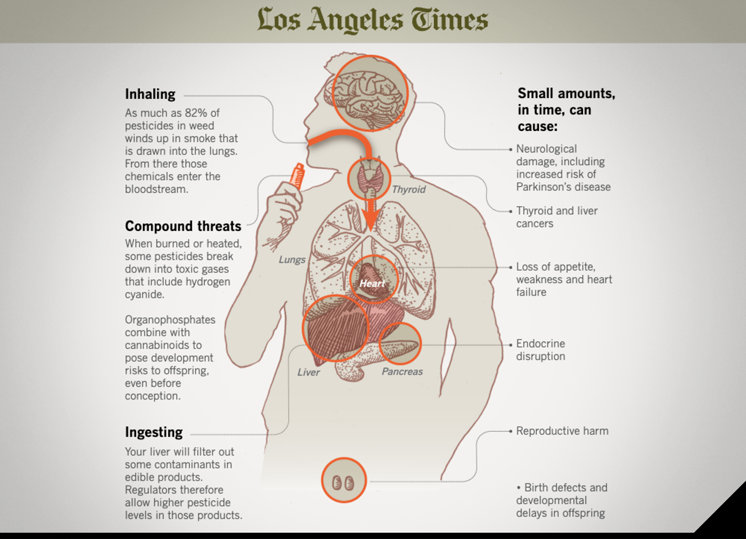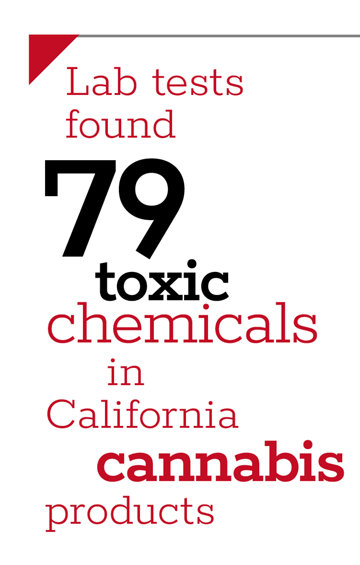OPP is a carcinogen and can cause kidney damage. Before its fall from favor, it was used in agriculture as a corrosive anti-mold soap. The chemical today is primarily used as a disinfectant in hospitals and dog kennels. It is not approved for use on cannabis.
The level of OPP found in the worker’s legal cannabis was so high that the vice president of the lab could muster only one word to describe it: “Disgusting.”
Process it into vape oils, and the chemicals are concentrated 10 times over.
The worker’s bout with the one-two punch of a dangerous drug laced with a dangerous drug was not an isolated instance. Far from it.
An LA Times investigation revealed that California’s legal and allegedly “monitored” cannabis crop yields a toxic harvest—including a smorgasbord of deadly, unregulated, hazardous pesticides on top of what is already a dangerous, mind-altering gateway drug.
Cannabis has been associated with lung damage, psychosis and an increased risk of heart attack (you’re 500 percent more likely to have one within the first hour of smoking pot).
The dozens of different pesticides identified—including unregulated or illegal substances found in California’s legal marijuana market—have been linked to various cancers, neurological damage, reproductive harm, heart failure, birth defects and Parkinson’s disease.

Cannabis, by its very nature, then compounds the impact of the deadly soup of chemicals by itself acting like an addict. The plant, aided by technology, possesses accelerated growth and respiration rates, making it a super-sponge for any itinerant poison. It sops up and concentrates heavy metals and pesticides from the soil and air—even trace amounts that drift on the wind from nearby farms or seep out of old drywall.
Process it into vape oils, and the chemicals are concentrated 10 times over.
Inhale it and up to 82 percent of the pesticides enter the lungs as smoke and, from there, enter the bloodstream, carrying them to internal organs, including the brain.
It gets worse. Heat from combustion causes certain pesticides to degrade into harmful gases like hydrogen cyanide, which can cause coma, cardiac arrest, seizures and temporary blindness.
The LA Times conducted hundreds of tests for pesticides on more than 370 legal cannabis products from 86 brands bought from state-licensed stores, along with products from tobacco shops and unlicensed outlets. The analysis checked for more than 290 pesticides beyond the 66 chemicals already included in California’s mandatory screening requirement for cannabis products.

The lab tests found 79 toxic chemicals in California cannabis products, including 44 that state regulators don’t monitor. The resulting 16 pages of dangerous chemicals include chlorfenapyr—an insecticide banned from use on food products—at a level over 2,000 times the amount permitted by the EPA. Exposure can result in chest tightness, vomiting and memory loss. When combusted, chlorfenapyr releases hydrogen cyanide.
Another chemical, pymetrozine, found in a third of state-legal cannabis products, is a carcinogenic toxin banned in the EU, Canada and Norway, and under restricted use in the US. The residue rate tested at 839.4 times the amount allowed by the EPA.
Is this shocking? Not to the people responsible for regulating California’s cannabis. Let’s take another look at pymetrozine, for instance. Word of mouth spread quickly among cannabis growers that the pesticide was “awesome” on the pesky aphids threatening their crops. One grower, Scott Eaton, reported using it 76 times in a two-year period.
“We were all communicating with each other about how great it was,” he said.
But the use of pymetrozine is illegal on cannabis.
Yet its use, as well as the use of other banned substances, has become so casual and routine that cannabis growers think nothing of including it in their monthly pesticide use report to state and county regulators (who, one assumes, can read).
Moreover, emails dating back to 2019 indicate that state regulators knew about the spreading use of the illegal chemical and even informed state agencies charged with safeguarding the public from such pesticides, but no action was taken.
It’s no secret, then, that toxic, life-threatening chemicals are blanketing California’s “legal” cannabis crop. It’s such common knowledge, in fact, that everyone knows about it except the public.
In fact, the heaviest pesticide loads were found in legal products.
The Department of Cannabis Control, for its part, issued a stoic statement dismissing the scandal as “part of the maturation process of a newly regulated sector,” then unplugged its phone to any interview requests.
Cannabis producers are already pushing a dangerous, potentially addictive substance on millions.
Why poison a poison?






















